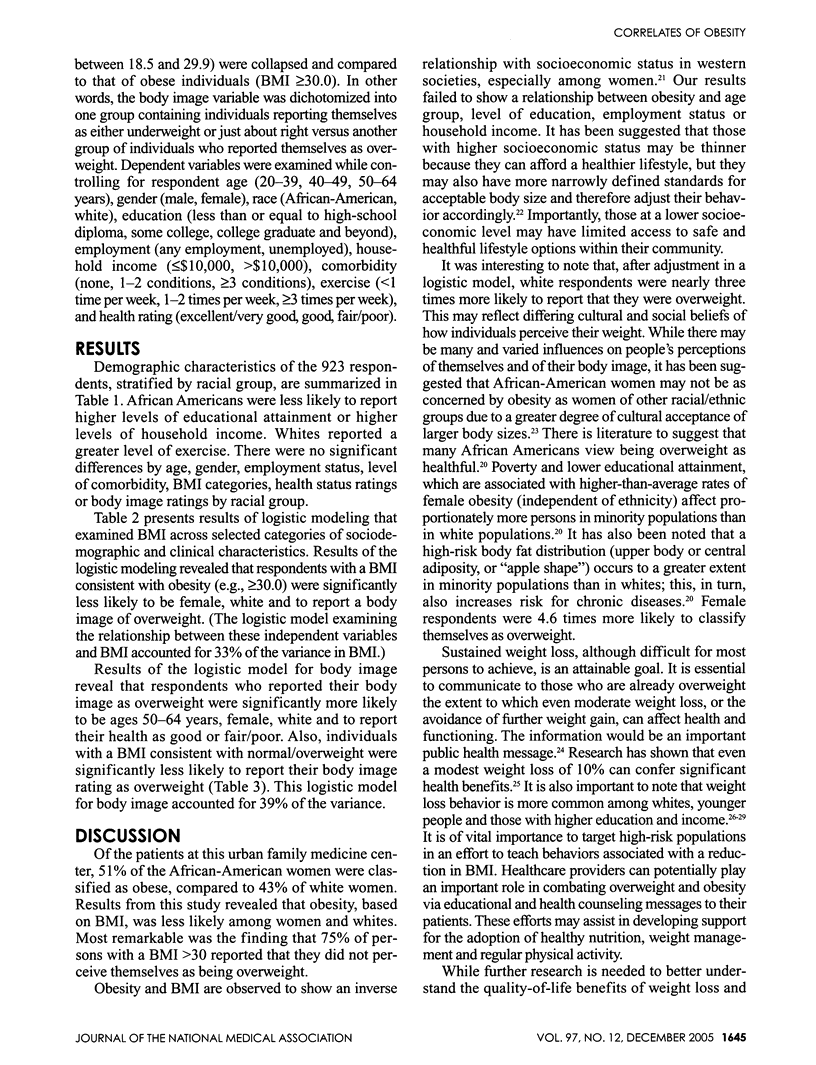Abstract
Urban populations face unique health challenges. We used data from a cross-sectional comprehensive health risk assessment survey conducted at an urban family medicine center to explore demographic and clinical correlates of obesity among 923 adults ages 20-64 years. Based on univariate analyses, there were no significant differences for body mass index (BMI) categories or health status ratings by racial group. A logistic model revealed that obese respondents (BMI >30.0) were significantly less likely to be female, white and to report a body image of overweight. Overall, just 25% of persons with a BMI of >30 classified themselves as being overweight. A second logistic model revealed that respondents reporting a body image of overweight were significantly more likely to be age 50-64 years, female, white and to report their health as good or fair/poor, which may reflect differing cultural and social beliefs of how individuals perceive their weight. This misperception between calculated BMI and reported body image in this urban population may serve to moderate attempts to address weight control as a health issue.
Full text
PDF






Selected References
These references are in PubMed. This may not be the complete list of references from this article.
- Airhihenbuwa C. O., Kumanyika S. K., TenHave T. R., Morssink C. B. Cultural identity and health lifestyles among African Americans: a new direction for health intervention research? Ethn Dis. 2000 Spring-Summer;10(2):148–164. [PubMed] [Google Scholar]
- Allan J. D., Mayo K., Michel Y. Body size values of white and black women. Res Nurs Health. 1993 Oct;16(5):323–333. doi: 10.1002/nur.4770160503. [DOI] [PubMed] [Google Scholar]
- Bowen D. J., Tomoyasu N., Cauce A. M. The triple threat: a discussion of gender, class, and race differences in weight. Women Health. 1991;17(4):123–143. doi: 10.1300/j013v17n04_06. [DOI] [PubMed] [Google Scholar]
- Cachelin F. M. Ethnic differences in body-size preferences: myth or reality? Nutrition. 2001 Apr;17(4):353–354. doi: 10.1016/s0899-9007(00)00590-6. [DOI] [PubMed] [Google Scholar]
- Cachelin F. M., Striegel-Moore R. H., Elder K. A. Realistic weight perception and body size assessment in a racially diverse community sample of dieters. Obes Res. 1998 Jan;6(1):62–68. doi: 10.1002/j.1550-8528.1998.tb00316.x. [DOI] [PMC free article] [PubMed] [Google Scholar]
- Kuczmarski R. J. Prevalence of overweight and weight gain in the United States. Am J Clin Nutr. 1992 Feb;55(2 Suppl):495S–502S. doi: 10.1093/ajcn/55.2.495s. [DOI] [PubMed] [Google Scholar]
- Kumanyika S. K. Special issues regarding obesity in minority populations. Ann Intern Med. 1993 Oct 1;119(7 Pt 2):650–654. doi: 10.7326/0003-4819-119-7_part_2-199310011-00005. [DOI] [PubMed] [Google Scholar]
- Neff L. J., Sargent R. G., McKeown R. E., Jackson K. L., Valois R. F. Black-white differences in body size perceptions and weight management practices among adolescent females. J Adolesc Health. 1997 Jun;20(6):459–465. doi: 10.1016/S1054-139X(96)00273-X. [DOI] [PubMed] [Google Scholar]
- Powell A. D., Kahn A. S. Racial differences in women's desires to be thin. Int J Eat Disord. 1995 Mar;17(2):191–195. doi: 10.1002/1098-108x(199503)17:2<191::aid-eat2260170213>3.0.co;2-z. [DOI] [PubMed] [Google Scholar]
- Riley N. M., Bild D. E., Cooper L., Schreiner P., Smith D. E., Sorlie P., Thompson J. K. Relation of self-image to body size and weight loss attempts in black women: the CARDIA study. Coronary Artery Risk Development in Young Adults. Am J Epidemiol. 1998 Dec 1;148(11):1062–1068. doi: 10.1093/oxfordjournals.aje.a009583. [DOI] [PubMed] [Google Scholar]
- Smith D. E., Thompson J. K., Raczynski J. M., Hilner J. E. Body image among men and women in a biracial cohort: the CARDIA Study. Int J Eat Disord. 1999 Jan;25(1):71–82. doi: 10.1002/(sici)1098-108x(199901)25:1<71::aid-eat9>3.0.co;2-3. [DOI] [PubMed] [Google Scholar]
- Sobal J., Stunkard A. J. Socioeconomic status and obesity: a review of the literature. Psychol Bull. 1989 Mar;105(2):260–275. doi: 10.1037/0033-2909.105.2.260. [DOI] [PubMed] [Google Scholar]
- Stephenson M. G., Levy A. S., Sass N. L., McGarvey W. E. 1985 NHIS findings: nutrition knowledge and baseline data for the weight-loss objectives. Public Health Rep. 1987 Jan-Feb;102(1):61–67. [PMC free article] [PubMed] [Google Scholar]
- Strauss R. S. Self-reported weight status and dieting in a cross-sectional sample of young adolescents: National Health and Nutrition Examination Survey III. Arch Pediatr Adolesc Med. 1999 Jul;153(7):741–747. doi: 10.1001/archpedi.153.7.741. [DOI] [PubMed] [Google Scholar]


